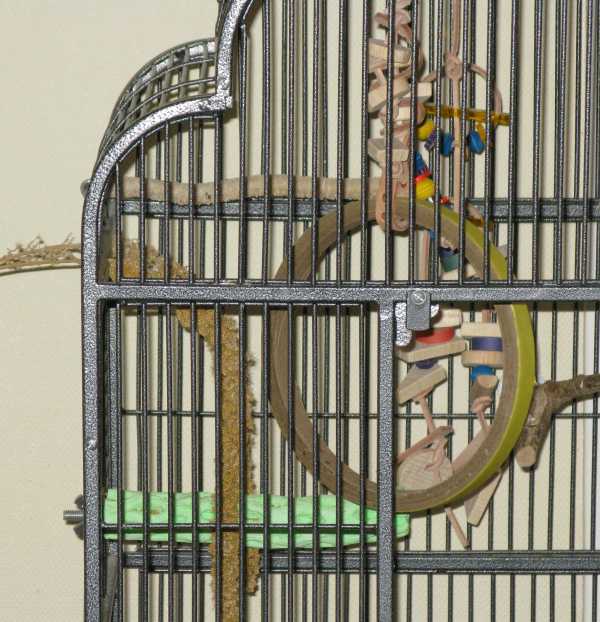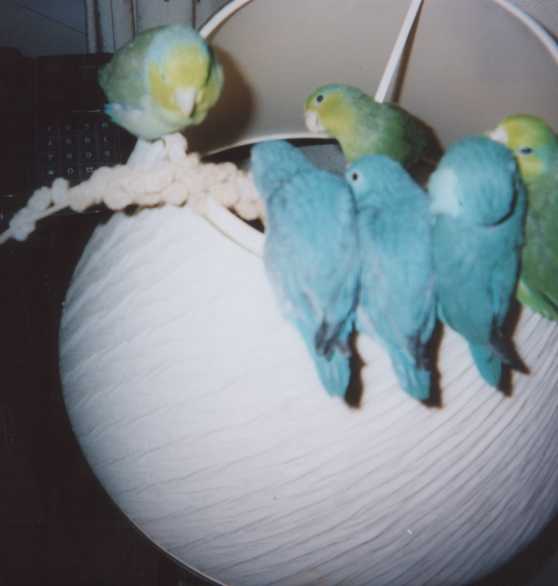 are and Housing
are and Housing are and Housing
are and Housing
|
Parrotlets - while small - are very active birds, and although their housing requirements are not great, they still require more space than you might think. As with all exotic birds, they also have specific dietary requirements, which will not be met by standard pet-shop seed diets alone. This isn't to say that Parrotlets are difficult to care for; in fact, with the right advice, even a first time bird owner should easily be able to keep these beautiful little birds.  Your Parrotlet's CageParrotlets should be kept in a cage at least 24" long, 16" high, and 14" deep (approx. 610mm x 410mm x 360mm in metric); width being more important than height as your birds will enjoy flying back and forth across the interior.There should be horizontal bars on at least two sides to allow for climbing. Bar spacing should be no more than 0.5" (12mm) otherwise a Celestial will be able to fit its head through the space, and is likely to become trapped. Powder-coated steel construction is the safest option, in my opinion. Many cheaper cages, especially in the past, have been coated with zinc, and this has been shown to be highly poisonous to birds, causing aggression and ultimately death. Food dishes should not have a hood covering them, as many Parrotlets will not risk putting their head in to such an enclosure, even if it means dying by dehydration or starvation. Uncovered dishes should be either mounted on the sides of the cage near accessible perches or placed on the cage floor (being mindful of overhead perch positions to prevent food from becoming spoiled by faeces). It is advisable to pay close attention to your Parrotlet during the first few days of it coming home, as some younger birds may not be comfortable eating from side mounted dishes. It may become necessary to provide shallow dishes on the floor, and introducing the side mounted dishes slowly, if so desired. It is not recommended to keep more than one Parrotlet in the same cage. A male and a female may be kept together, although patience may be required when introducing them to each other, perhaps keeping them in seperate cages initially and letting them play together while supervised. You must be prepared, however, for the possibility that this may lead to breeding. Even if you do not provide a nestbox, a determined pair will find a way, such as laying in a food dish. This means, of course, that related males and females cannot be kept together after they reach sexual maturity. With great care, and individual bird temperament allowing, it is also possible to keep two hens together, safe in the knowledge that breeding is not possible. Parrotlets , however, are very territorial, and there may be vicious fighting. Cock-birds, being the more aggressive sex in this species, are even worse. I have read of two males being kept together, but this is the exception rather than the rule and not recommended, especially for anyone lacking experience with these birds. Parrotlets have been known to bite the toes, and even feet, from other Parrotlets! Attempting to keep a Parrotlet in the same cage as another species is even less feasible: smaller birds will most certainly be attacked; and larger birds... Parrotlets do not have any idea of their small stature and will probably attack a larger bird too. I don't think I need to explain the potential dangers involved when a parrot as small as a Parrotlet attacks something much larger than itself. As long as it is given enough toys in its cage, and enough personal contact with you, a single Parrotlet can be kept without any trouble. If you do wish to keep more than one of these fantastic little birds (and let's face it, why wouldn't you!) seperate cages are always an option, their cage requirements aren't too demanding! Enriching Your Parrotlet's CageParrotlets are very active and intelligent birds, especially when compared with other birds of a similar size. It has often been commented that Parrotlets are very much like small Amazons. Given this, it is important to keep a Parrotlet from becoming bored; and since it is likely that the bird will spend many hours in its cage, one should be sure to furnish the cage with a variety of suitable bird toys.Swings are always a favourite, and should almost certainly be provided. It is also advisable to include bird-safe chewing toys, as this will help satisfy a Parrotlet's natural urge to chew, while also helping to keep beak growth in check. Please don't assume that because a toy is for sale in a pet-shop, it must be bird-safe! Bird toys are not regulated, and there are many "toys" on the market that have enormous design flaws that could easily injure a bird. Common sense is usually the best way to proceed -look for parts that could come loose easily, small spaces in which a bird could get part of its body trapped, and pay attention to any metal fittings - properly constructed stainless steel for preference.  A variety of perches of varying sizes should be included throughout. Natural wood is best, as long as it's not of a poisonous variety. Safe natural branches are good for a birds feet due to the variable profile along the branches length, and the branch can (and probably will!) be gnawed by the bird. In addition to trees listed as poisonous, trees that have been treated with pesticides are also unsuitable, as are trees growing in highly polluted areas (next to a very busy road, for example). If in doubt, don't use the branch. Other commercially available options include sand-coated perches, which are very good for keeping nails trim (put one high in the cage where the Parrotlet is likely to roost for best results); and heat-treated natural perches - such as java-tree branches - which make for a relatively robust solution that still has a natural profile. Robustness, however, comes at the cost of chewability, and java in particular can be too smooth for a comfortable foot-hold. A good mixture of all of these should make for a happy P'let! Parrotlet NutritionParrotlets, as mentioned earlier, are very active birds. They therefore require a well balanced diet.A typical Parrotlet diet consists of a high quality small hookbill mix that includes sunflower, such as cockatiel mix; fresh vegetables and fruit; sprouted seed; and wholegrain breads. Cuttlefish should be made available at all times to prevent calcium deficiency. Obviously, fresh water should be available at all times, and refreshed regularly. Many Parrotlets will bathe themselves in their water dish, and this will necessitate more frequent replenishment. Drink tubes are not recommended for Parrotlets. Parrotlets should also be given access to high protein foods such as mashed hard-boiled or scrambled egg (with the shell for extra calcium) and egg-food, which can be purchased from a good avian food supplier. Spray millet is an easily digested food that is highly coveted by most species of parrot, Parrotlets being no exception. It is very fatty however and should only be given in moderation.  Some people prefer to use a pellet based diet, supplemented with fruit and vegetables and only a small amount of seed. I cannot personally recommend such diets, but it is an option that exists and does have some advantages - pellets are fortified with beneficial vitamins. Vitamin additives are all very well, but other additives in pellets include things like artificial colouring, and this is the source of my objection. There are numerous reports of previously good tempered birds becoming aggressive and irritable after converting to a pellet diet; there are also reports of higher instances of kidney problems developing in later life when on a pellet diet. Many parrots- of all species, not just Parrotlets - will not even touch pellets, and if these are all you offer then there is a possibility of starving your Parrotlet. Birds on a normal seed based diet can enjoy the same vitamin benefit by having a supplement added to their food several times a week, either to egg food or sprinkled on their vegetables. Birds on a pellet diet, on the other hand, should not have these supplements as, in conjunction with the pellets own vitamins, it is possible to over-dose. In my experience, favoured foods include: grated carrot, broccoli, sweet-corn, baby sweetcorns, apple (remove the pips*) and chickweed. Frozen vegetables can be used, but should be allowed to defrost to room temperature before serving. Any beans should be well cooked and allowed to cool. Try various vegetables out, and see what your bird likes - every Parrotlet's taste vary, and you don't want to bore your bird with the same food day in, day out. Do not use avocado, birds cannot digest these properly, and they can therefore prove poisonous. I tend to choose organically grown produce - for myself, but particularly for my birds - because the other, more conventional, means of production tends to result in fruit and vegetables that contain residual pesticides. Strawberries are particularly bad for this, and if you choose to feed strawberries to you Parrotlet then I most strongly encourage that these, even if nothing else, be organic. Further Reading: Taking Care of Your New Baby, by Elizabeth Jones *Apple seeds contain a small amount of cyanide. Bear in mind that a bird's digestive system is designed to digest seeds more thoroughly than a humans and that a Parrotlet is many times smaller. While a very large amount of apple seed would be required to harm a human, only a moderate amount would be required to harm a small bird. If your bird does eat a seed by mistake, don't panic! As long as this isn't happening regularly, then you shouldn't experience any problems. | |||||||||
|
Page created 16 March 2008 Last modified: 14 May, 2008 Iain D. Kendall |